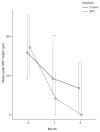Evaluation of the Safety and Efficacy of Selective Retina Therapy Laser Treatment in Patients with Central Serous Chorioretinopathy
- PMID: 33307626
- PMCID: PMC7904406
- DOI: 10.3341/kjo.2020.0112
Evaluation of the Safety and Efficacy of Selective Retina Therapy Laser Treatment in Patients with Central Serous Chorioretinopathy
Abstract
Purpose: To assess the safety and efficacy of selective retina therapy (SRT) using a Q-switched neodymium-doped yttrium lithium fluoride laser with feedback systems in patients with idiopathic central serous chorioretinopathy (CSC).
Methods: This randomized clinical trial enrolled patients having at least 3-month symptom of CSC. From month 3 visit, all subjects in both groups were eligible for SRT retreatment if they showed persistent or recurrent subretinal fluid (SRF). The primary outcome was complete resolution of SRF by optical coherence tomography at 3 months after treatment. The secondary outcomes were changes in SRF, central macular thickness (CMT) and best-corrected visual acuity at the 1-, 3-, and 6-month examinations.
Results: Sixty-eight CSC patients were included (SRT, 31; control, 37). After 1 and 3 months, complete resolution of SRF was achieved in 25.8% and 54.8% of SRT group and 17.6% and 35.1% of controls. The differences were not statistically significant (p = 0.424 and p = 0.142, respectively). However, mixed model for repeated measures analyses showed that the reduction of SRF and CMT were observed earlier in SRT group than in the sham group (least squares mean difference, -59.7 µm; 95% confidence interval, -98.2 to -21.2; p = 0.0029; least squares mean difference -67.0 µm; 95% confidence interval, -104.8 to -29.2; p = 0.0007, respectively). Significant reduction of SRF (≥50% reduction from baseline) was more frequently observed in SRT group (80.6%) than the sham group (44.1%) at month 1 (p = 0.007). Early reduction of SRF and CMT was more abundant in SRT group with symptom duration less than 6 months. Treatment related serious adverse events were not observed.
Conclusions: SRT using a Q-switched neodymium-doped yttrium lithium fluoride laser with feedback system was safe in this trial and effective for early resolution of SRF in the CSC patients. Early intervention with SRT can be a safe alternative for patients with acute symptomatic CSC.
Keywords: Central serous chorioretinopathy; Clinical trial; Laser treatment; Subthreshold micropulse laser.
Conflict of interest statement
Though this study was supported by Lutronic Vision, Inc., the collection, the analysis, and the interpretation of data had been done independently by authors.
Figures




References
-
- Daruich A, Matet A, Dirani A, et al. Central serous chorioretinopathy: recent findings and new physiopathology hypothesis. Prog Retin Eye Res. 2015;48:82–118. - PubMed
-
- Fok AC, Chan PP, Lam DS, Lai TY. Risk factors for recurrence of serous macular detachment in untreated patients with central serous chorioretinopathy. Ophthalmic Res. 2011;46:160–3. - PubMed
-
- Matet A, Daruich A, Zola M, Behar-Cohen F. Risk factors for recurrences of central serous chorioretinopathy. Retina. 2018;38:1403–14. - PubMed
-
- Ooto S, Hangai M, Sakamoto A, et al. High-resolution imaging of resolved central serous chorioretinopathy using adaptive optics scanning laser ophthalmoscopy. Ophthalmology. 2010;117:1800–9. - PubMed
Publication types
MeSH terms
Grants and funding
LinkOut - more resources
Full Text Sources
Other Literature Sources
Miscellaneous

